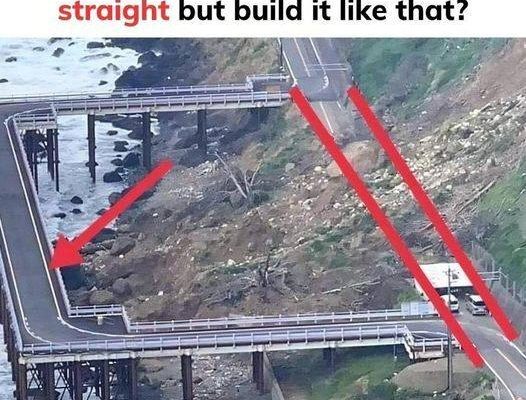When you see a bridge that doesn’t go in a straight line, you might think about why engineers picked a curved or angled design instead. Wouldn’t it be easier and more effective to have a straight bridge? Actually, designing bridges is not random at all; there are strong reasons why some bridges don’t follow the direct path. Let’s explore why engineers create curved bridges and how these designs help protect against natural forces like landslides.
The Significance of Bridge Design: More Than Just Looks

At first sight, a curved bridge may look like an artistic choice to make it more attractive. While looks can matter sometimes, the main reasons are based on practicality and safety. Engineers think about many factors such as the landscape, environmental risks, and structural strength. Often, a curved or angled bridge can offer better durability, less environmental harm, and greater resistance against natural forces.
One big reason for choosing curves in bridge designs? Landslide prevention! But how does the shape of a bridge connect to landslides? And why would engineers steer clear of straight paths when building them? Let’s break this down.
How Landslides Affect Bridge Design
Landslides are natural dangers that can cause serious damage to infrastructure. In areas where landslides happen often, straight bridges might not be the safest choice. A landslide can put huge pressure on a bridge; if it hits at just the wrong angle, it could lead to major failures.
By using curves or angles in their designs, engineers create bridges that handle or avoid landslide impacts better. Curved bridges provide several advantages in areas prone to these hazards:
Redirecting Force: A curved structure helps redirect force from a landslide away from itself. Instead of hitting directly on one point which could cause collapse,a curve allows energy to spread out more evenly.
Avoiding Unstable Ground: Straight bridges may cross over places that are very likely to experience landslides. By curving around these risky spots ,engineers place structures on steadier ground reducing chances for damage.
Better Weight Distribution: Curved designs spread weight across multiple points making them stronger against sudden forces from slides . This feature boosts stability while lowering stress on any single part of the structure.
Curved Bridges and Natural Terrain: Working with Nature
Often ,engineers select curved designs so they fit with nature’s layout .This method has many perks including less disruption for ecosystems while matching up with land’s flow .Here’s how working with terrain helps:
Protecting Nature: When built alongside nature ,there’s less need for digging which harms local wildlife habitats .Curving around hills avoids cutting through important areas keeping ecosystems safe .
Reducing Erosion : Straight structures often need lots of land changes leading erosion over time.Curved ones adapt better minimizing ground alterations thus lowering erosion risks .
Improved Stability : Building on stable untouched ground is safer & cheaper.Curves let builders dodge unstable soil ensuring solid foundations .
Engineering Perks of Curved Designs
Besides protecting against slides & caring for environment ,curvy designs bring engineering benefits boosting strength & durability.Let’s check out some technical advantages making them popular choices:
1.Improved Load Distribution

Curvy shapes help share weight evenly across structures.Unlike straights focusing loads at specific points,a curve spreads weight reducing stress overall especially useful for long spans improving stability .
2.Increased Flexibility in Construction
Curves allow designers flexibility adapting plans based upon available space.In crowded cities or rough terrains,a straight option might not work due obstacles.Curves fit tighter spaces navigating around issues still providing safe routes .
3.Enhanced Structural Integrity
Curvy forms resist vibrations/movements crucial where earthquakes,strong winds exist.The curvature absorbs/dissipates energy effectively compared with flat shapes making them tougher against outside pressures .
Real-World Examples Of Curvy Bridges

Many famous worldwide showcase practical benefits from curvy styles.Here are few examples :
Chesapeake Bay Bridge-Tunnel (Virginia): Spanning 17 miles includes curves avoiding strong currents/geological threats providing safer route across bay.
Millau Viaduct (France): One tallest globally features slight curve following valley below enhancing beauty while reducing impact surrounding environment.
Shibanpo Yangtze River Bridge (China): Its curve bypasses unstable riverbank zones cutting down risk slide damage helping navigate tough terrain along river valley.
The Future Of Bridge Design : Balancing Safety And Innovation
As new materials/construction methods develop future designs will likely become even smarter/adaptive.Trend towards curviness reflects broader shift prioritizing safety/environmental care/longevity .
In coming years we may witness advanced smart tech incorporated monitoring integrity detecting slides adjusting automatically under changing conditions.For now though,the curvy design stands testament human creativity creating structures harmonizing well within nature!
Conclusion : The Hidden Brilliance Behind Curved Bridges
While straightforward options seem easiest sometimes those bends offer much better solutions especially where slides threaten! These clever constructions safeguard environments ensuring safe travels generations ahead.Next time crossing one take moment appreciate thoughtfulness behind its creation.It isn’t just path between two points—it represents engineering artistry built withstand nature’s challenges!



